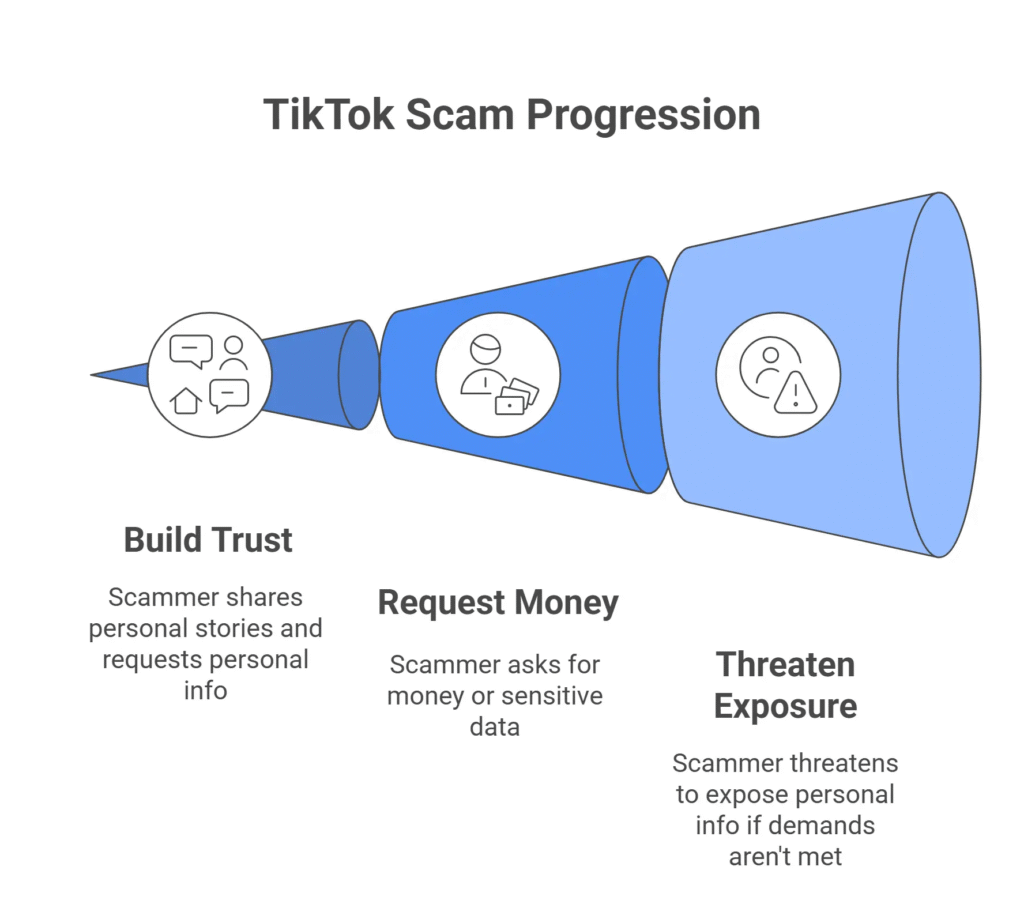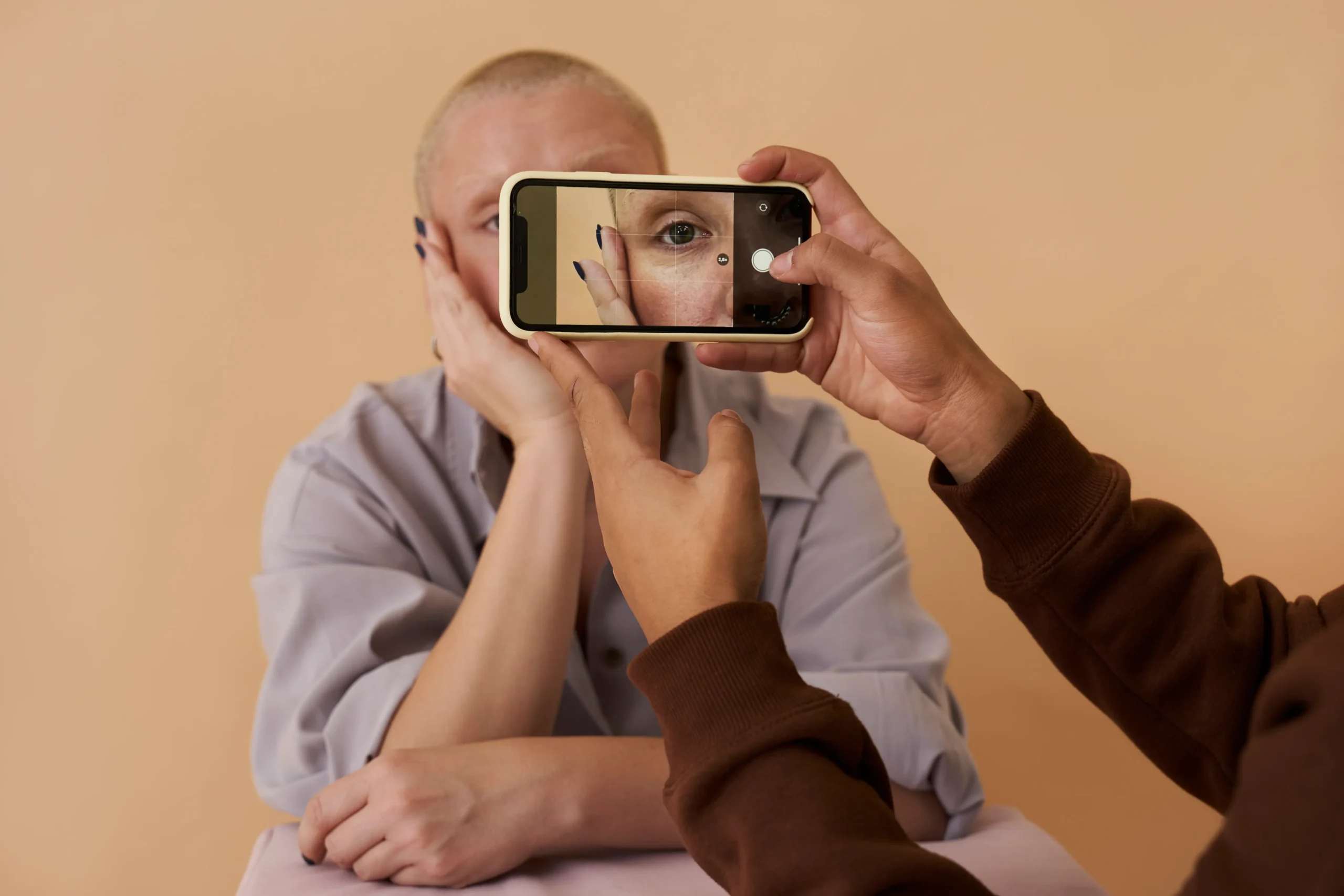If you spend time on TikTok, you’ve probably seen profiles that look almost too perfect to be real. The so-called TikTok scammer girl accounts pretend to be young women or use stolen photos to earn people’s trust. The Federal Trade Commission (FTC) reported more than $12.5 billion in losses from online scams.
In this post, we’ll walk you through how these fake TikTok accounts typically work, the signs you should watch out for, how to respond if one reaches out to you, and the safest way to report these scams. You’ll also find real examples and practical tools to help you keep your personal data protected and stay free of romance scams.
Need support after a scam? Join our community today.
What Is A TikTok Scammer Girl And Why Is It Dangerous?
A TikTok scammer girl is an account that uses a real, fake, or deepfake identity to steal money, personal details, or intimate material. These aren’t random fake profiles; many are part of organized groups that use trust to get sensitive information.
The same thing happens with scammers on Facebook Messenger and other social platforms. They use fake photos, casual conversations, and a false sense of familiarity to get closer to their targets. Over time, that contact can lead to manipulation, blackmail, or data theft.
Why Is It Dangerous?
This type of fraud depends on emotional pressure and speed. Scammers use deepfake videos, fake influencer profiles, or giveaways to convince victims to send money or private photos. Once they have something to use as a tool, the threats begin: they could claim they’ll post images or reach out to family members.
Common tactics include:
- Impersonation and extortion.
- Use of fabricated videos or fake promotions.
- Moving the conversation to WhatsApp or Telegram.
- Creating urgency to push a quick reaction.
Practical Example
Picture a young man who enjoys posting travel clips and fun challenges on TikTok. A popular account starts commenting on his videos and sending friendly messages. The conversation becomes more personal, and she eventually suggests moving to WhatsApp “to talk more privately”.
Soon, her tone changes. She asks for intimate photos, promising that no one else will see them. Hours later, the threat appears: if he doesn’t send money, she’ll publish the images and tag his friends. It’s a situation that mirrors hundreds of digital extortion cases investigated by the FBI.

TikTok Scammer Girl: How the Scam Works and How to Stay Safe
The TikTok scammer girl profiles work in a predictable pattern. They start by catching your attention, slowly build a sense of trust, and once you’re emotionally involved, the manipulation begins. But learning how each phase begins helps you react before things get serious.
1. Targeting
The scammer sets up a fake profile that looks real, using attractive photos, short videos, and friendly comments to seem genuine. She starts with small talk, compliments, or casual messages to draw you in.
How to detect it
- New account with only a few posts or little interaction.
- Photos that look reused or edited.
- Persistent invitations to move the chat to WhatsApp or Telegram.
- Promises of easy money, paid work, or instant rewards.
What to do
Take a moment before replying. Look up the username on Google or TikTok to see if it appears on another platform. If her tone feels too personal too soon, the best move is to block and ignore.
2. Building Trust
Once she has your attention, she starts creating emotional closeness. She may tell a personal story, send selfies, or ask for your number to keep the conversation going. When she feels you trust her, the requests start with money, private photos, or sensitive data.
How to detect it
- Messages that sound overly emotional or intimate.
- Requests for “proof of trust”, like private pictures or videos.
- Random offers of help, gifts, or financial support.
What to do
Before cutting contact, save all evidence. Take screenshots showing the username, message history, and any links or contact details. If money or transfers were involved, keep every receipt. This information will help if you decide to file a report through IC3 or TikTok’s help center.
3. Constant Threats
Once the scammer gets what she wanted, like money, images, or private details, the conversation changes. The tone becomes aggressive. She threatens to post your pictures, contact your friends, or share your chats.
How to detect it
- Messages that sound hostile or urgent.
- Warnings like “I’ll post your photos” or “if you don’t pay, everyone will see.”
- Demands for more money through new accounts or payment apps.
What to do
- Do not reply. Any answer gives her more control.
- Report the profile on TikTok using the Report option.
- File a complaint with IC3 to document the case.
Have questions about dealing with scams? Contact us for support.

What Common Mistakes Put You at Risk of a TikTok Scammer Girl?
A TikTok scammer girl usually counts on three big mistakes: sending money when harassed, moving the chat outside the app, and trusting fake promotions or profiles. But following a pattern depends less on their skills and more on a victim’s reaction. One quick decision, made under pressure, can turn into a persistent problem.
Mistake 1: Paying for Silence
When scammers threaten to post private messages or photos, many victims panic and send money, thinking it will end the situation. But every payment incites more demands.
- Example: A user gets a message asking for $300 to keep their photos private. After paying, another message arrives the next day asking for double. Each transfer gives the scammer more control and less reason to stop.
Mistake 2: Moving the Chat to Another App
TikTok’s safety tools stop working once the conversation moves to WhatsApp or Telegram. Outside the platform, messages can be deleted, accounts vanish, and evidence becomes harder to trace.
- Example: A man meets a friendly profile on TikTok who invites him to keep chatting on Telegram. Two days later, her account disappears from TikTok, and the threats begin in the new app. When he tries to report it, there’s nothing left to prove what happened.
Mistake 3: Trusting Fake Giveaways or Collaborations
Some scammers pretend to represent brands or influencers. They offer “partnerships,” quick payments, or contests that sound too good to be true, and then send links to fake websites that collect personal or banking data.
- Example: A user receives a message from someone claiming to work for a popular clothing brand. The person sends a form with the brand’s logo and asks for bank details to “process payment”. The link, yet, leads to a phishing page that steals the user’s credentials.
How to Report a TikTok Scammer Girl Account
When you deal with a scam on TikTok, acting quickly can make a real difference. Each reporting option serves a different purpose: some stop the spread of content, while others help you recover lost money or protect your online identity.
Best Ways to Report a TikTok Scammer Girl Account
| Type of channel | Cost | Difficulty | Protection level | Real example |
| Direct payments (Zelle, Cash App, Venmo) | Free | High | No refund | After sending money to a fake account, most banks won’t reverse the transaction. The safest move is to keep every receipt and contact your bank’s support team to report it. |
| Official reports (TikTok, IC3, NCMEC) | Free | Medium | High with evidence | In sextortion or underage cases, TikTok allows you to file a report directly from the profile. The IC3 investigates cross-border scams, while the NCMEC handles sensitive content involving minors. |
| Digital reputation monitoring | Monthly | Low | Continuous prevention | Tools such as DeleteMe or ReputationDefender help locate and remove leaked personal data, images, or links before they spread further online. |
Each method plays a different role:
- Official reports can stop the content from spreading.
- Banks and payment platforms allow you to document and dispute unauthorized transactions.
- Reputation monitoring services help you keep personal information under control.
Real Cases Of TikTok Scammer Girl
Recent reports have detailed how organized groups use TikTok to manipulate users, blackmail them, and steal money. Similar methods are now appearing in AI voice scamming, where synthetic voices are used to imitate real people and pressure victims into sending funds or sharing personal details.
Here are real cases that explain how these scams work and the kind of impact they’ve had on victims around the world:
Case 1: Deepfake With Influencer And Extortion In Brazil
According to Reuters, a criminal network released a fake video using Gisele Bündchen’s face to promote fake ads. These ads promised rewards or partnerships, but once users clicked, the scammers demanded money to avoid sharing their personal data.
The operation extends across several Latin American countries, leading Brazilian authorities to open fraud investigations. Many victims lost large sums of money and faced lasting damage to their public image.
Case 2: Sextortion Targeting Teenagers In The United States
The FBI recorded multiple incidents where fake profiles posed as “models” and contacted teenagers. After gaining their trust, the scammers asked for intimate photos and then demanded payment, threatening to expose the content to friends or relatives.
Many victims felt trapped, and in some cases, families contacted child protection agencies for support and intervention.
Case 3: The BM Boys Network In Nigeria
Reported to The Guardian, this group has been operating through TikTok and Instagram, extorting users from different countries. They use encrypted chats, ghost accounts, and fake payment systems to cover their tracks. Once they collect private material, they threaten to release it online.
International authorities traced several money transfers, which led to arrests in Nigeria and other countries involved in the scheme.

Your Best Strategy Against A TikTok Scammer Girl: Detect, Block, And Report
When you face a TikTok scammer girl, the smartest thing to do is act quickly. Collect proof, block the account, and file a report through official channels. Never send money or reply. If your personal data or images have already been shared, cut all communication right away.
Online safety doesn’t depend on technical skills. What really helps are steady habits that protect your data, like scams on LinkedIn often involve fake recruiters or company profiles that look professional to earn your trust. At Cryptoscam Defense Network, we make digital protection simple and practical.
✅ Download our Fraud Report Toolkit to easily collect, organize, and report scam cases, with dropdowns for scam types, payment methods, platforms, and direct links to agencies like the FTC, FBI, IC3, CFPB, BBB, and more.
We Want to Hear From You!
Fraud recovery is hard, but you don’t have to do it alone. Our community is here to help you share, learn, and protect yourself from future fraud.
Why Join Us?
- Community support: Share your experiences with people who understand.
- Useful resources: Learn from our tools and guides to prevent fraud.
- Safe space: A welcoming place to share your story and receive support.
Find the help you need. Join our Facebook group or contact us directly.
Frequently Asked Questions (FAQ) About TikTok Scammer Girl
Is “TikTok Scammer Girl” A Real Person Or A Category?
TikTok scammer girl is not a real person, but a term used to group different profiles created for blackmail or identity theft. Many of these accounts are managed by organized groups who build fake personas to earn trust and manipulate users through misleading interactions.
Why Do They Ask To Switch To WhatsApp Or Telegram?
Scammers push conversations to WhatsApp or Telegram because those apps offer less moderation and fewer safety controls than TikTok. Once the chat moves there, messages can be deleted, accounts can vanish, and the evidence becomes harder to trace for reports or investigations.
What Should I Do If I Already Sent Money?
Reach out to your bank or payment app immediately and file a dispute, attaching screenshots as proof. In some regions, financial institutions work with cybercrime units to track fraudulent transactions. Acting quickly can improve your chances of recovering the money.







